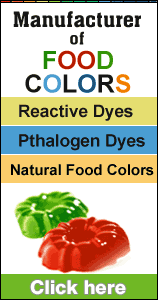A Roman saying goes that people "eat with their
eyes" as much as with their palates. Saffron and other spices were
often used to provide a rich yellow color to various foods even in the
ancient civilizations. Let alone children, even adults are attracted towards
colored food.
But what are food color additives? Technically speaking, a color additive
is any dye, pigment or substance that can impart color when added or applied
to a food, drug, cosmetic or to human body. Food colors are used in
virtually every food product, be it dairy, confectionery, beverages, bakery
and even cereals.
Types and Certification
Food colors used today are both synthetic and natural. Natural food colors
for industrial or domestic use do not need any certification but the
synthetic ones have to be certified for their safety standards by
organizations like FDA (Food and Drug Administration) in United States of
America. E.C. Marked colors are certified by the European Community. They
have their own testing methods and numbering systems. The "approval"
process or color additive certification, assures safety, quality,
consistency and strength of the color additive prior to its use in foods.
Irrespective of the source that is natural or synthetic, colors have to be
certified for their safety to be added to any food. Usually for the
commercial purposes, artificial colors are preferred as they are more
stable, provide better color uniformity and blend together easily.
Certifiable color additives generally do not impart undesirable flavors to
foods, while color derived from foods can produce such effects. The amount
of color used in a particular food also has to be regulated and this
regulation is known as Good Manufacturing Practices.
Certified color additives are known as dyes or lakes. Dyes are
water-soluble and can be used in beverages, dry mixes, baked goods,
confections, dairy products, pet foods, and other products. Lakes are
insoluble in water and are more stable than dyes. They are preferred in
foods containing fats and oils or those not having too much moisture like
tablets, cake mixes, candies, and chewing gums.
Why Use Color Additives
Though there is a growing realization that the color additives should be
used to the minimum, the fact is that the food doesn't even look presentable
at times without it and appears inedible. Colors are used to bring a
variation and maintain the natural appeal of the preserved food. Other uses
include:
- To preserve the color loss due to exposure environmental
extremes.
- To correct natural variations in color.
- To enhance colors that occur naturally.
- To provide a colorful identity to foods.
- To protect flavors and vitamins that may be affected by sunlight
during storage.
|




